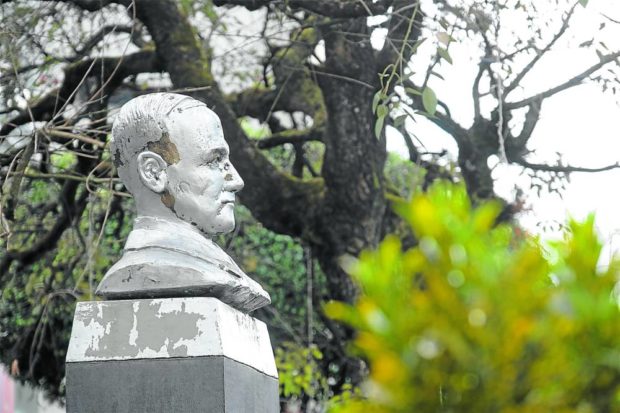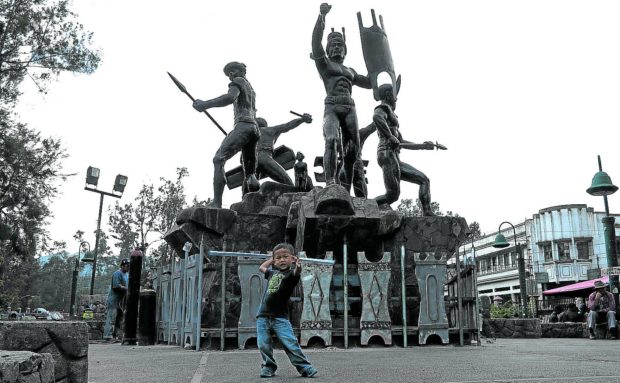Baguio wants to keep statues, monuments safe from vandals

COMMUNITY PARK The bust of George Malcolm, the American lawyer credited for crafting the Baguio City charter, stands in a mini park named after him in the summer capital’s business district. Malcolm Square, also known as People’s Park, is among the popular gathering places for locals where community events, even protest actions and political rallies, have been held. —NEIL CLARK ONGCHANGCO
BAGUIO CITY—Several years ago, vandals cut off parts of the metal loincloths worn by five Cordilleran statues at Igorot Park in the city’s business district.
But it took until Valentine’s Day this year for repairs of the monument sculpted by Abdulmari “Toym” de Leon Imao Jr. to be contemplated in a proposed resolution filed by two councilors during the council’s regular session this week.
“They look like they’re wearing diapers,” said Councilor Benny Bomogao, who sponsored the repair request along with Councilor Vladimir Cayabas, chair of the council committee on education, culture, creativity and historical research.
On Wednesday, city planning officer Donna Tabangin said the local government was studying how best to protect all artistic, cultural and historical artifacts placed under the city’s custody.
The local government has an ongoing cultural mapping project and is drawing up a heritage protection plan that is part of efforts that began in 2019 to redevelop Baguio, said Tabangin, an architect.
What the government is trying to work out is how to finance conservation and protection measures, she said.

TRIBUTE The Cordillera Freedom Monument, unveiled in 2002 at Igorot Park in Baguio City, pays tribute to indigenous peoples in the region. But the statues of local warriors, depicted in traditional clothing, have been vandalized several years ago, prompting city officials to discuss ways to protect cultural pieces and historical structures in Baguio. —EV ESPIRITU
Partnerships
According to Tabangin, the city may also establish partnerships with the private sector, the property owners where the heritage structures or artifacts are located, and with “those who appreciate heritage and history.”
Former city tourism officer Benedicto Alhambra on Thursday said forming a department with the sole task of securing and maintaining cultural and historical artifacts and heritage sites could be an option for the local government.
Alhambra had reported the Igorot Park vandalism, and had been furious at park security at the time because tearing off the metal shards from the statues comprising Cordillera Freedom Monument would have taken a long time.
The bust of American architect Daniel Burnham, for whom the city’s main park was named, had also been vandalized several years ago. Its metal tiles were pried off, prompting the late journalist Narciso Padilla to replace them with concrete slabs.
At Malcolm Square, vandals stole the pair of eyeglasses from the bust of Supreme Court Justice George Malcolm, who is credited for drafting the Baguio charter and for establishing the University of the Philippines (UP) College of Law.
The problem also involves the city’s storage facilities, with some artists complaining that paintings and other pieces donated to the Baguio government need temperature-controlled, properly secured rooms in order to be preserved.
Culture club
Alhambra said Baguio residents formed an informal club called “Project Cast” (culture, arts, sports, tourism) in 1988 to try to inventory cultural properties and to design cultural and historically relevant programs for leisure travelers. It was the same period when the local art community formed Baguio Arts Guild.
“Stronger efforts at protecting cultural artifacts are more important today,” Alhambra said, noting that Baguio became the country’s first city to join the Creative Cities Network of the United Nations Educational, Cultural and Scientific Organization.
Baguio’s mapping project has reached out to residents, civic groups and the academe for historic places and cultural properties which should be recognized as part of Baguio’s heritage.
The city itself is considered a “living heritage site” by some experts, having been designed and built as a hill station by the American colonial government in the early 1900s.
“We want to dig deeper and truly understand what matters most to us in terms of heritage and culture. So we would have a common narrative,” Tabangin said.